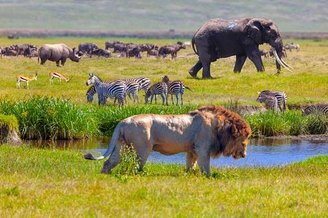Although the request to formalize the Anthropocene as a new geological epoch was recently rejected by the International Commission on Stratigraphy (ICS), Human interventions on Earth are so extensive that they are causing profound impacts on the planet.
For this reason, some scientists are investigating whether the Covid-19 pandemic is a kind of “nature’s response” to the negative impact of humans on the environment.
The thesis is not new. In 2010, a decade before the epidemic that killed nearly seven million people, the respected Australian virologist Frank Fenner stated that humanity will become extinct within the next 100 years due to overpopulation, environmental destruction and climate change.
What will happen to Earth after human extinction?
University of Iowa urban design professor Carlton Basmajian, in his article published on The Conversation platform in June 2023, states that the first major impact of human disappearance will be perceived by the ear, not the eye.
The world would be silent and only a privileged surviving observer could notice how noisy we, our buildings, and our cars were. Basmajian says that after a year without humans, the sky will be bluer and the air cleaner. Over time, wind and rain will clear the Earth’s surface of much of the dust and pollution produced by humans.
Anyone returning home that first year would likely have had no water or electricity, let alone a TV, Wi-Fi signal or computer. But there will definitely be many new, strange plants in the garden and garden. And there is also a large insect population in the air.
A world without us: extinction

While researching his book “A World Without Us,” journalist Alan Weisman visited a tropical forest in Guatemala called Tikal, where there are traces of a nearly two-thousand-year-old Mayan fortress. Today the city is a UNESCO World Heritage Site and one of Guatemala’s most popular tourist attractions.
But at the time, Weiman only saw truly dense rainforests and hills. “And archaeologists later explained that the places you were actually walking through were unexcavated pyramids and cities.”he told LiveScience.
This meant that civilization would never have been known beneath the soil and vegetation of the forest if there had not been humans to uncover and restore its ruins. “It’s incredibly exciting how quickly nature can bury us,” Weisman said. So what would cities, industries and nature itself be like without humans?
World Cities: Decline and Rebirth

In Weisman’s research, which is based on the unexpectedly sudden and complete extinction of the human race, the first result will be the subways in cities such as London and New York being flooded in approximately 36 hours due to the failure to manage groundwater. Then will come accidents caused by lack of human care at oil refineries and nuclear power plants.
In the midst of this initial chaos, nature will find a way to evolve (it always does)and soon the ancient “stone forest” would be covered with pastures, shrubs, and dense woodlands. The accumulation of dry leaves and twigs creates the perfect flammable material to fuel any possible fire.
But Weisman predicts that all this charred material “will be great for nurturing biological life. The streets will grow into little meadows and forests that will grow within 500 years.”
What would animal species be like on an Earth without humans?

According to Søren Faurby, professor of macroecology and macroevolution at the University of Gothenburg, habitats — consists of plant communities, soils, waterways, and oceans — If they survive the long-term exposure of the chemicals, wildlife will move in and “settle in.”
This transition has the potential to increase biodiversity on a global scale in ways never seen before, says Faurby. In an interview with LiveScience, he says: before humans spread around the world (and reduce megafauna populations)The Earth will become as diverse as the Serengeti in terms of these species, he said, referring to Tanzania’s famous national park, which is considered one of the largest wildlife ecosystems in the world.
Weisman says people reject environmentalists’ predictions for fear of realizing that damage to the planet is hastening our own demise. “I discovered that one way to get rid of the fear factor was to simply kill. [os humanos] First”, jokes. Freed from emotion, it was possible to focus on what he wanted to say.
“I wanted people to see how nature could beautifully bounce back and even heal many of the wounds we left on this planet. And then consider: Is there a way to reintegrate ourselves into this restored image of Earth?” – concludes Weisman.
Did you like the content? So stay updated with more topics like this on TecMundo and take the opportunity to understand how close the planet Earth is to a new mass extinction.
Source: Tec Mundo
I’m Blaine Morgan, an experienced journalist and writer with over 8 years of experience in the tech industry. My expertise lies in writing about technology news and trends, covering everything from cutting-edge gadgets to emerging software developments. I’ve written for several leading publications including Gadget Onus where I am an author.













